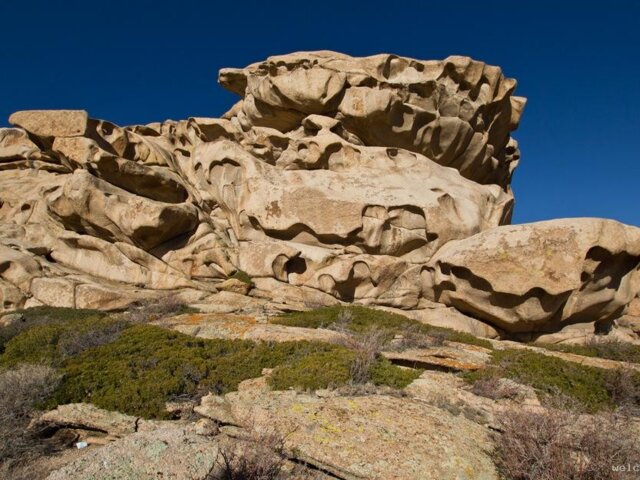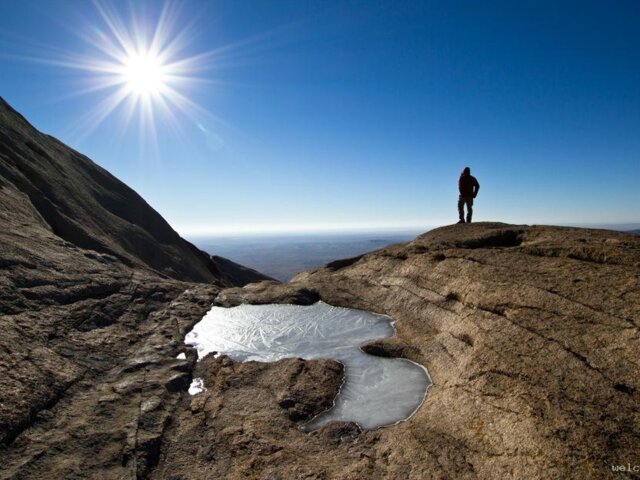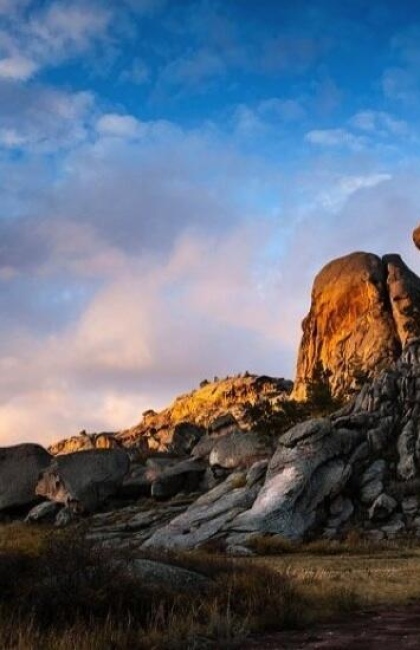Bektau Ata Tract
A Lone Mountain in the Flatlands
About an hour north of Lake Balkhash, in the middle of an endless plain, a stone giant suddenly breaks the horizon – the Bektau Ata Tract. For hundreds of kilometers the steppe stretches flat and uniform, so the sight of these granite mountains feels almost unreal, like a mirage.
Millions of years ago, a volcano began to form here, but it never erupted: a solid plug blocked the vent. Magma rose and cooled beneath the surface, and over time erosion stripped away the upper layers, exposing a massive granite dome. Wind and water continued the work, carving the rocks into fanciful shapes. After rain, natural stone basins fill with water, forming small pools in the hollows.
Life Among the Rocks
Moisture and shade draw wildlife into the ravines. Mountain argali, saiga antelope, and goitered gazelle inhabit the area, along with predators such as wolves. Rodents are also found here, as well as a variety of bird species. In the cracks between the rocks grow juniper, hawthorn, meadowsweet, and the endemic Bektau Ata sweetvetch.
Aulie Tas Cave
On the southwestern slope, at an altitude of about 600 meters (1970 ft), there is a cave. In front of the entrance lies a flat area roughly 5 by 7 meters. You can walk about 15 meters inside, after which the ceiling drops and water begins. Without caving equipment, going any farther is not possible.
A Magnet for Climbers and Photographers
Rock climbers have long set their sights on Bektau Ata. There are dozens of routes, ranging from simple to extremely technical. Most are not equipped, so climbers must bring their own gear. The highest point, Mount Bektau Ata, rises over 1,200 meters (3937 ft). Nearby stand other peaks: Sarykulja, Konyrkulja, Karashoky, and more.
Photographers come here for the light and the shapes. At dawn, the rocks take on a pink hue, and after rain the granite glistens with a wet sheen. History enthusiasts are drawn by evidence of life and activity stretching back thousands of years. .jpg)
Traces of Distant Eras
The Bektau Ata oasis has been inhabited since Neolithic times. During the Bronze Age, ore was mined here and transported to Persia, India, China, and Egypt. Later, during the Silk Road era, the mountain served as a landmark for caravans on the Northern Route. Its peak is visible from afar on a clear day.
Rich deposits, trade routes, and striking nature made this place a hub for ancient clan communities. Burial sites from different periods still lie at the foot of the mountains: Scythian and Turkic burial mounds, and even earlier complexes. During the age of the Huns, Bektau Ata was considered sacred. Rituals, negotiations, and horse races were held here. Until the late 19th century, it remained an important stop on the trade routes around Lake Balkhash.
No Comforts, Just Wilderness
There are no comforts of civilization here – no hotels, no cafés, no marked trails. In summer, you’ll need to bring your own water and food. Wear sturdy shoes with good grip, because after rain the granite becomes slippery. Plan your route so you’re back before dark.
With popularity came problems: litter, graffiti on stones, and remnants of campfires. Despite its scientific importance, the area has no protection or oversight.
How to Get There?
Bektau Ata lies about 70 km (43 mi) north of the town of Balkhash, close to the Karaganda-Balkhash highway. As you drive along the road, you’ll spot the massif from afar. By car, you can get almost to the foot of the mountain.
Other tourist attractions near the Bektau Ata Tract:
- Northern Shore of Lake Balkhash
- Resorts on the Northern Shore of Lake Balkhash
- Shunak Meteorite Crater
- Agybai Batyr Mausoleum
- Kyzylarai Mountains
- Begazy Necropolis
- Aktau Mountains





